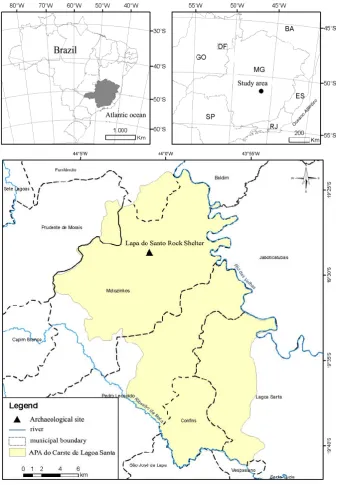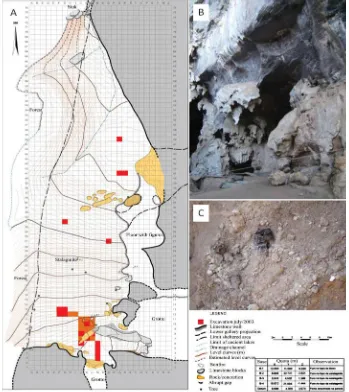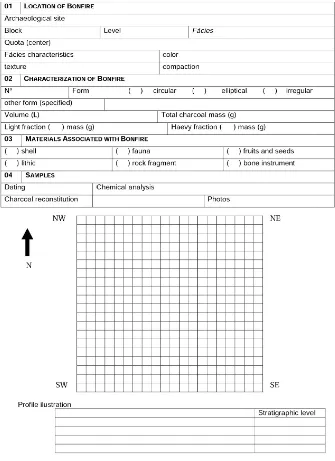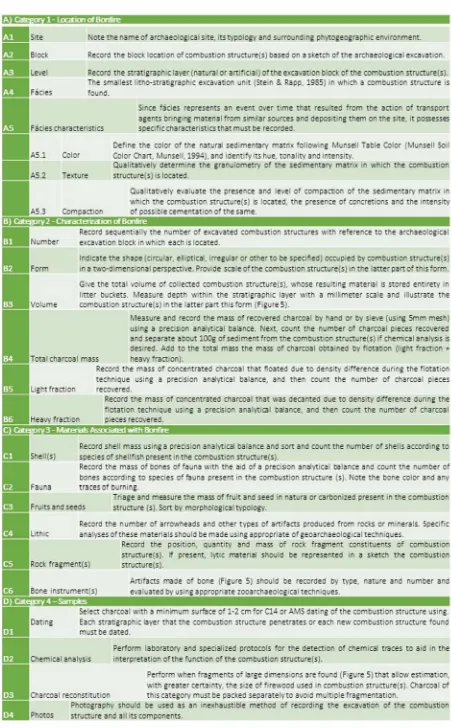ORIGINAL RESEARCH ARTICLE
A NEW ARCHAEOBOTANICAL PROTOCOL FOR COLLECTING
CONCENTRATED WOOD CHARCOAL FROM ARCHAEOLOGICAL
BONFIRE SITES
João Carlos Ferreira de Melo Júnior
Laboratório de Anatomia e Ecologia Vegetal, Programa de Pós-Graduação em Patrimônio Cultural e Sociedade,
Universidade da Região de Joinville, Rua Paulo Maschitzki, 10, CEP 89219-710, Joinville – SC, Brasil
ARTICLE INFO ABSTRACT
Wood charcoal is the most commonly found bioarchaeological testimony at archaeological sites. In addition to dating sites, charcoal provides insights into the way of life of past populations and paleoenvironment reconstruction. Concentrated charcoal is usually recovered from archaeological bonfires. This paper proposes a new field protocol for standardized collection and registration of archaeological charcoal recovered from combustion structures, and which can be applied to different types of archaeological sites. The protocol was developed from field experiments involving excavation of archaeological sites in central Brazil. The systematization of information acquisition provided by this tool assures more effective sampling of concentrated charcoal and, therefore, the optimization of data for deeper paleoethnological interpretations.
Corresponding author:
Copyright ©2017,João Carlos Ferreira de Melo Júnior. This is an open access article distributed under the Creative Commons Attribution License, which permits unrestricted use, distribution, and reproduction in any medium, provided the original work is properly cited.
INTRODUCTION
Plant remains recovered from sedimentary matrices of archaeological sites fall into two categories: microremains, characterized by phytoliths, pollen grains, spores, starch grains, crystals and siliceous bodies (Pearsall, 2000); and macroremains, represented by fruits, seeds, fibers, leaves,
wood in natura and charcoal (Ford, 1979). These remains
constitute the botanical remnants that, after deposition, have passed or not through some type of taphonomic transformation and remained in archaeological sediment as important testimony for the interpretation of some aspects of the way of life of previous populations. Carbonized wood or charcoal is one of the main macroremains found in archaeological sites (Scheel-Ybert, 2004), given its advantages for preservation over other types of plant remains due its carbonization, to park
the wood decomposition and to enable its preservation (Pearsall, 1988). Charcoal represents a faithful portrait of the flora that originally surrounded an archaeological site. It is deposited in the archaeological matrix in two distinct manners, which allow two different types of interpretations. Dispersed charcoal occurs randomly scattered throughout a site or part thereof. Concentrated charcoal occurs already assembled in combustion structures or bonfires. Dispersed charcoals lend themselves to inferences about the composition of past flora and allow paleoenvironmental reconstruction. Concentrated charcoal of bonfires, although representing a small portion of the diversity of the floristic paleoenvironment, offers direct evidence of the use of flora by previous populations and is more reliable for paleoethnological and paleoethnobotanical investigations and interpretations about resource exploitation, relationships between society and the environment, and
ISSN: 2230-9926
International Journal of Development Research
Vol. 07, Issue, 08, pp.14241-14247, August,2017
Article History: Received 29th May, 2017
Received in revised form 25th June, 2017
Accepted 16th July, 2017
Published online 30th August, 2017
Available online at http://www.journalijdr.com
Citation: João Carlos Ferreira de Melo Júnior. 2017. “A new archaeobotanical protocol for collecting concentrated wood charcoal from archaeological
bonfire sites”, International Journal of Development Research, 7, (08), 14241-14247.
ORIGINAL RESEARCH ARTICLE Open Access
livelihood systems (Pearsall, 1983, Thompson, 1994, Chabal et
al., 1999, Figueiral, 2005, Mallol et al., 2007, Melo Júnior &
Magalhães, 2015). Although archaeological charcoal is the target of almost all archaeological studies, mainly because it is used for dating and understanding the evolution of human occupation and abandonment of an archaeological site, and is innovatively recovered in the field by flotation (Chabal, 1988; Pearsall, 2000), there remains an absence of a complete standardized procedure specifically for the treatment of
concentrated charcoal. Standardization of collecting
bioarchaeological remains is focused essentially on the availability of archaeobotanical or zooarchaeological samples that can be compared among sites with regard to the
paleoenvironment (Silva et al., 2013). Important works have
made broader propositions for standardized recovery and sampling of bioarchaeological macroremains based on
innumerable experiences of researchers of Brazilian
archeology.
These propositions evidence not only the need for systematization of field procedures in order to obtain comparable data in the fields of antracology, archaeobotany
and zooarchaeology (Scheel-Ybert et al., 2005-2006), but also
the need for the refinement of techniques for sample treatment
at certain archaeological sites (Silva et al., 2013).
[image:2.595.139.479.275.761.2]In these works, the protocols and techniques adopted are, for the most part, intended for dispersed charcoal. Concentrated charcoal, on the other hand, is approached in a rather detailed manner, which raises doubts as to the best set of field procedures to be followed to systematize studies that employ it as a source of archaeobotanical information. Based on experiments performed at Brazilian archaeological sites, the present study proposes a new protocol specifically designed for the recovery of concentrated charcoal from combustion structures at archaeological sites.
Figure 1. Location of Lapa do Santo archaeological site, Carste Lagoa Santa, municipality of Matozinhos,
MATERIALS AND METHODS
The proposed protocol for concentrated charcoal was developed from field excavation experiences at the Lapa do Santo archaeological site headed by the bioanthropologist Walter Alves Neves of the Laboratory of Human Evolution of the University of São Paulo, Brazil. Lapa do Santo is a rock shelter located on Fazenda Cauaia in the Lagoa Santa enviromental protection area, municipality of Matozinhos, state of Minas Gerais, Brazil (S 19º28’39.6”, W 44º00’55.9”;
Figure 1). It is characterized as a cave of approximately 930m2
in area with a wide sheltered area (1,300m2) at its entrance. It
possesses a relatively flat, dry floor in its southern portion near the entrance, and a steep slope in its northern portion, where it
becomes flat again in the vicinity of a sink (Araújo et al.,
2005).
The site has experienced successive stages of excavation, with the first being undertaken in 2001 involving a topographic survey and the opening of a block for probing. In 2002, new open blocks revealed an archaeological deposit of more than 3m-deep and evidence of human burials. Between 2003 and
2005, excavations were expanded, making a more
comprehensive view of the stratigraphy of the area of greatest occupation of the site possible, with 2005 concentrating on the exhumation of human skeletons from, mostly secondary, burials. In 2006 and 2007, excavations were completed in the blocks considered to be the food preparation area of the site,
and great efforts were made in the excavation of a second level of burials. In 2008, the excavation of burials was completed and the extent of the excavations closed, exposed profiles rectified and final recordings of site stratigraphy taken. In total, excavation encompassed 31 open blocks, revealing a homogeneous sedimentary matrix of a variegated gray-color interspersed by concrete levels containing archaeological
material deposited uninterruptedly, including several
combustion structures (Figure 2). Radiocarbon dating from approximately two meters depth was 8880 ± 50 years BP
(Figure 3) (Neves et al., 2008).
RESULTS AND DISCUSSION
The new protocol for the collection of concentrated charcoal (Figure 4) encountered among combustion structures during the excavation of archaeological sites (Figure 5) emphasizes
[image:3.595.125.474.247.639.2]the systematization of information that must be carefully recorded in the field so that more in-depth interpretations can arise from its analysis. The protocol requires the researcher to record information grouped into four categories as listed in the table below, which also provides detailed recommendations for completing the protocol and explanations of the nomenclature used. The architecture of combustion structures reveals the spatial distribution of rock fragments of varying sizes and lithic natures together with partially or totally intact wood charcoal, seeds, bones and other traces of animals, which are the targets of various archaeological studies of
Figure 2 - Lapa do Santo archaeological site, Carste Lagoa Santa, municipality of Matozinhos, state of Minas Gerais, Brazil. Legend:
A - sketch of excavation blocks. B - front view of the shelter. C - combustion structure. Source: Melo Júnior & Magalhães (2015).
Figure 3. Calibrated radiocarbon age obtained for a combustion structure of the Lapa do Santo archaeological site,
Carste Lagoa Santa
[image:4.595.118.453.310.771.2]Figure 4. Newly proposed protocol for the collection of concentrated charcoal from combustion structures and recording associated information at
Figure 3. Calibrated radiocarbon age obtained for a combustion structure of the Lapa do Santo archaeological site,
Carste Lagoa Santa, municipality of Matozinhos, state of Minas Gerais, Brazil
Figure 4. Newly proposed protocol for the collection of concentrated charcoal from combustion structures and recording associated information at Brazilian archaeological sites
Figure 3. Calibrated radiocarbon age obtained for a combustion structure of the Lapa do Santo archaeological site, Gerais, Brazil
Table 1. Recommendations for completion of the newly proposed protocol for collecting charcoal concentrated in combustion structures of archaeological sites
Figure 5. Lapa do Santo archaeological site, Carste Lagoa Santa, municipality of Matozinhos, state of Minas Gerais, Brazil. Legend: A – excavation of combustion structure. B - front view of
combustion structure (dashed). C - bone tip (arrow) associated with combustion structure. D - large carbon fragment (dashed). E
- combustion structure in profile view (dashed line)
ethnology given its immediate association with food preparation (Melo Júnior & Magalhães, 2015). In addition, studies conducted at prehistoric and historical archaeological sites in different parts of the world have found that food preparation is not dissociated from other activities, such as the practice of rituals or heat treatment of raw materials
(Gonçalves, 2003; Beuclair et al. 2009; Cabral, 2014). On the
other hand, although existing and published protocols in specialized literature for Brazilian archaeological sites are important tools for standardizing field methods for the reliable analysis and interpretation in an archaeological context
(Scheel-Ybert et al., 2005-2006), they are very general and
superficial regarding combustion structures and the
concentrated charcoal therein. The proposal presented here contributes to the advancement of standardization of field protocols by focusing on charcoal concentrates in combustion structures, the knowledge of which contributes a wealth of information to understanding the food, diet and other practices associated with the way of life of previous populations.
REFERENCES
Araujo AGM, Neves WA, Piló LB, Atui JPV 2005. Holocene dryness and human occupation in Brazil during the “Archaic Gap”. Quaternary Research. 64:298-307.
Beuclair M, Scheel-Ybert R, Bianchini GF, Buarque A 2009. Fire and ritual: bark hearths in South-American Tupiguarai mortuary rites. Journal of Archeological Science. 36:1409-1415.
Cabral DC 2014. Na presença da floresta: mata atlântica e história colonial. Rio de Janeiro: Garamond.
Chabal L, Fabre L, Terral JF, Théry-Parisot I 1999. L´anthracologie. In Ferdière A (Ed.) La botanique. Coll. Archaeologiques. Errance, Paris.
Chabal L 1988. Pourquoi et comment prélever les charbons de bois pour la période antique, les méthodes utilisées sur le site de Lattes (Hérault). Lattara. 1:187–222.
Figueiral I 2005. Quantification in charcoal analysis? Yes, but not always. Examples from problematic portuguese sites. VI Congresso Ibérico de Arqueometría. Avances em Arqueometría. pp 223-228.
Ford RI 1988. Little things mean a lot – quantification and qualification in paleoethnobotany. In Hastorf CA and Popper VS (Eds.) Current Paleoethnobotany: Analytical Methods and Cultural Intrpretations of Archaeological Plant Remains. The University of Chicago Press, Chicago, pp 215-222.
Gonçalves V 2003. Comer em reguentos, no Neolítico. As estruturas de combustão da área 3 de Xarez 12. Muita gente, poucas antas? Origens, espaços e contextos do Megalitismo. Actas do II Colóquio Internacional sobre Megalitismo. pp 81-99.
Mallol C, Marlowe FW, Wood BM, Porter CC 2007. Earth, wind and fire: ethnoarchaeological signals of Hadza fires. Journal of Archaeological Science. 34:2035-2052. Melo Júnior, JCF, Magalhães WLE 2015. Antracologia de
fogueiras paleoíndias do Brasil central: considerações tecnológicas e paleoetnobotânicas sobre o uso de recursos florestais no abrigo rupestre Lapa do Santo, Minas Gerais, Brasil. Antípoda Rev. Antropol. Arqueol. 22:137-161. Munsell Soil Color Charts 1994. Macbeth Division of
Kollinorgen Instruments Corporation.
Neves WA, Araujo AGM, Ceccantini GTC, Bueno LMR, Kipnis R, Bernardo DV, Hubbe A, Freire GQ, Melo Júnior JCF, Strauss AM, Perez CP, Nakamura C, Prado HM, Raczka M, Bissaro Júnior M, Almeida TF, Martin PMH, Cezário ME 2008. Origens e microevolução do homem na américa: uma abordagem paleoantropológica II. Relatório científico final. FAPESP 04/01321-6. 301p. Pearsall DM 1983. Evaluating the stability of subsistence
strategies by use of paleoethnobotanical data. Journal of Ethnobiology. 3:121-137.
Pearsall DM 1988. Interpreting the meaning of macroremain abundance: the impact of source and context. In Hastorf CA, Popper VS (Eds.) Current Paleoethnobotany: Analytical Methods and Cultural Interpretations of Archaeological Plant Remains. The University of Chicago Press, Chicago, pp 97-118.
Pearsall DM 2000. Paleoethnobotany: a handbook of
procedures. Orlando: Academic Press.
Scheel-Ybert R 2004. Teoria e métodos em antracologia. 1. considerações teóricas e perspectivas. Arquivos do Museu Nacional. 62(1):3-14.
Scheel-Ybert R, Klökler D, Gaspar MD, Figutti L 2005-2006. Proposta de amostragem padronizada para macro-vestígios bioarqueológicos: antracologia, arqueobotânica, zooarqueologia. Revista do Museu de Arqueologia e Etnologia. 15-16:139-163.
Silva FM, Shock M, Neves EG, Lima HP, Scheel-Ybert R
arqueológicos na Amazônia: nova proposta metodológica para estudos arqueobotânicos. Boletim do Museu Paraense Emílio Goeldi. Ciências Humanas. 8(3):759-769. Stein JK, Rapp G 1985. Archaeological sediments: A largely untapped reservoir of information. In Wilkie NC, Coulson WDE (Eds.) Contributions to aegean archaeology. Publications in Ancient Studies, Minnesota, pp 143-159.
Thompson GB 1994. Wood charcoals for tropical sites: a contribution to methodology and interpretation. In Hather JG (Ed.) Tropical Archaeobotany. Applications and New Developments. Routledge, London, pp 9-33.




